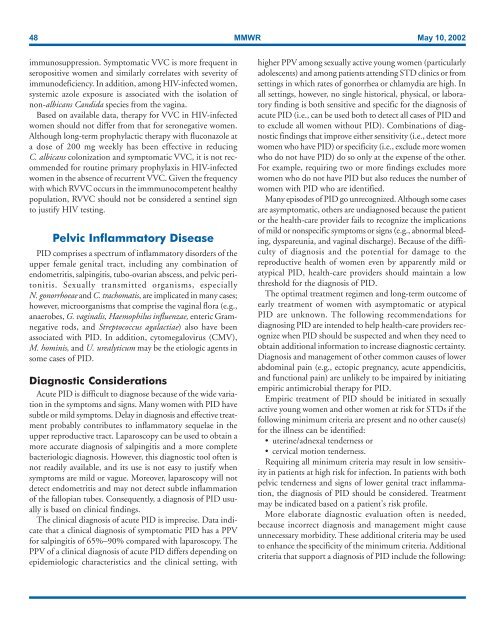You also want an ePaper? Increase the reach of your titles
YUMPU automatically turns print PDFs into web optimized ePapers that Google loves.
48 MMWR May 10, 2002<br />
immunosuppression. Symptomatic VVC is more frequent in<br />
seropositive women and similarly correlates with severity of<br />
immunodeficiency. In addition, among HIV-infected women,<br />
systemic azole exposure is associated with the isolation of<br />
non-albicans Candida species from the vagina.<br />
Based on available data, therapy for VVC in HIV-infected<br />
women should not differ from that for seronegative women.<br />
Although long-term prophylactic therapy with fluconazole at<br />
a dose of 200 mg weekly has been effective in reducing<br />
C. albicans colonization and symptomatic VVC, it is not recommended<br />
for routine primary prophylaxis in HIV-infected<br />
women in the absence of recurrent VVC. Given the frequency<br />
with which RVVC occurs in the immmunocompetent healthy<br />
population, RVVC should not be considered a sentinel sign<br />
to justify HIV testing.<br />
Pelvic Inflammatory Disease<br />
PID comprises a spectrum of inflammatory disorders of the<br />
upper female genital tract, including any combination of<br />
endometritis, salpingitis, tubo-ovarian abscess, and pelvic peritonitis.<br />
Sexually transmitted organisms, especially<br />
N. gonorrhoeae and C. trachomatis, are implicated in many cases;<br />
however, microorganisms that comprise the vaginal flora (e.g.,<br />
anaerobes, G. vaginalis, Haemophilus influenzae, enteric Gramnegative<br />
rods, and Streptococcus agalactiae) also have been<br />
associated with PID. In addition, cytomegalovirus (CMV),<br />
M. hominis, and U. urealyticum may be the etiologic agents in<br />
some cases of PID.<br />
Diagnostic Considerations<br />
Acute PID is difficult to diagnose because of the wide variation<br />
in the symptoms and signs. Many women with PID have<br />
subtle or mild symptoms. Delay in diagnosis and effective treatment<br />
probably contributes to inflammatory sequelae in the<br />
upper reproductive tract. Laparoscopy can be used to obtain a<br />
more accurate diagnosis of salpingitis and a more complete<br />
bacteriologic diagnosis. However, this diagnostic tool often is<br />
not readily available, and its use is not easy to justify when<br />
symptoms are mild or vague. Moreover, laparoscopy will not<br />
detect endometritis and may not detect subtle inflammation<br />
of the fallopian tubes. Consequently, a diagnosis of PID usually<br />
is based on clinical findings.<br />
The clinical diagnosis of acute PID is imprecise. Data indicate<br />
that a clinical diagnosis of symptomatic PID has a PPV<br />
for salpingitis of 65%–90% compared with laparoscopy. The<br />
PPV of a clinical diagnosis of acute PID differs depending on<br />
epidemiologic characteristics and the clinical setting, with<br />
higher PPV among sexually active young women (particularly<br />
adolescents) and among patients attending STD clinics or from<br />
settings in which rates of gonorrhea or chlamydia are high. In<br />
all settings, however, no single historical, physical, or laboratory<br />
finding is both sensitive and specific for the diagnosis of<br />
acute PID (i.e., can be used both to detect all cases of PID and<br />
to exclude all women without PID). Combinations of diagnostic<br />
findings that improve either sensitivity (i.e., detect more<br />
women who have PID) or specificity (i.e., exclude more women<br />
who do not have PID) do so o<strong>nl</strong>y at the expense of the other.<br />
For example, requiring two or more findings excludes more<br />
women who do not have PID but also reduces the number of<br />
women with PID who are identified.<br />
Many episodes of PID go unrecognized. Although some cases<br />
are asymptomatic, others are undiagnosed because the patient<br />
or the health-care provider fails to recognize the implications<br />
of mild or nonspecific symptoms or signs (e.g., abnormal bleeding,<br />
dyspareunia, and vaginal discharge). Because of the difficulty<br />
of diagnosis and the potential for damage to the<br />
reproductive health of women even by apparently mild or<br />
atypical PID, health-care providers should maintain a low<br />
threshold for the diagnosis of PID.<br />
The optimal treatment regimen and long-term outcome of<br />
early treatment of women with asymptomatic or atypical<br />
PID are unknown. The following recommendations for<br />
diagnosing PID are intended to help health-care providers recognize<br />
when PID should be suspected and when they need to<br />
obtain additional information to increase diagnostic certainty.<br />
Diagnosis and management of other common causes of lower<br />
abdominal pain (e.g., ectopic pregnancy, acute appendicitis,<br />
and functional pain) are u<strong>nl</strong>ikely to be impaired by initiating<br />
empiric antimicrobial therapy for PID.<br />
Empiric treatment of PID should be initiated in sexually<br />
active young women and other women at risk for STDs if the<br />
following minimum criteria are present and no other cause(s)<br />
for the illness can be identified:<br />
uterine/adnexal tenderness or<br />
cervical motion tenderness.<br />
Requiring all minimum criteria may result in low sensitivity<br />
in patients at high risk for infection. In patients with both<br />
pelvic tenderness and signs of lower genital tract inflammation,<br />
the diagnosis of PID should be considered. Treatment<br />
may be indicated based on a patient’s risk profile.<br />
More elaborate diagnostic evaluation often is needed,<br />
because incorrect diagnosis and management might cause<br />
unnecessary morbidity. These additional criteria may be used<br />
to enhance the specificity of the minimum criteria. Additional<br />
criteria that support a diagnosis of PID include the following:


